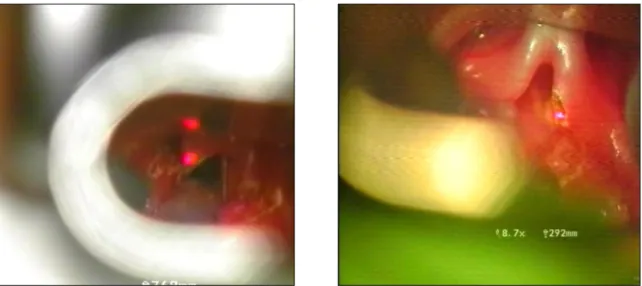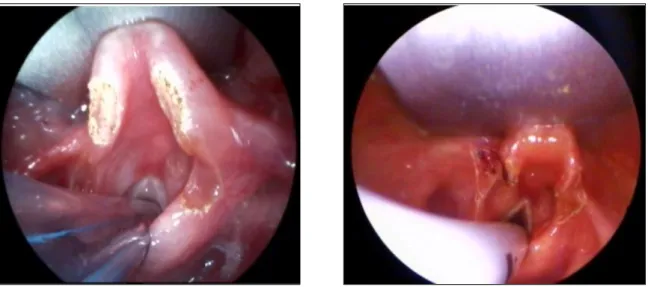CASE SERIES
Journal of Otorhinolaryngology and Facial Plastic Surgery 2019;5(3):1-4.
https://doi.org/10.22037/orlfps.v5i3.29826
--- This work is distributed under the terms of the Creative Commons Attribution Non Commercial 4.0 License
(CC BY-NC 4.0).
1
Changes in the Quality of Life of Our Neonatal Patients Born with Severe Laryngomalacia and Treated with Endoscopic UDP
Laser Supraglottoplasty
Gholam Hossein Alim Marvasti1*, Balazs Sztano1, Adam Bach1, Zoltan Tobias1, Laszlo Rovo1 1. Department of Oto-Rhino-Laryngology and Head and Neck Surgery, University of Szeged, Hungary.
Article Info Abstract
Article Note:
Received: August, 2019 Accepted: September, 2019 Publish Online: September, 2019
Corresponding Author:
Dr. Gholam Hossein Alim Marvasti
Email:
alimmarvasti@gmail.com
Keywords:
Laryngomalacia;
Ultra-dream pulse laser (UDP) supraglottoplasty;
Neonatal dyspnea and inspiratory stridor.
Background: Laryngomalacia is one of the most common causes of neonatal dyspnea and inspiratory stridor. In 20% of the cases laryngomalacia in newborns may lead to respiratory failure, feeding difficulties and failure to thrive. The aim of this study was to assess the changes in the quality of life of the patients with laryngomalacia in the first year following ultra-dream pulse laser supraglottoplasty.
Case presentation: the assessment relevant parameters of 6 newborn patients with laryngomalacia (4:2 male:female, average age at the time of operation 12,5 days) who underwent ultra-pulse laser supraglottoplasty.
Conclusion: Ultra-dream pulse laser supraglottoplasty for laryngomalacia is a safe and effective surgical modality, even if it is performed in the neonatal age.
Conflicts of Interest: The Authors declare no conflicts of interest.
Please cite this article as: Alim Marvasti GH, Sztano B, Bach A, Tobias Z, Rovo L. Changes in the Quality of Life of Our Neonatal Patients Born with Severe Laryngomalacia and Treated with Endoscopic UDP Laser Supraglottoplasty. J Otorhinolaryngol Facial Plast Surg 2019;5(3):1-4.
https://doi.org/10.22037/orlfps.v5i3.29826
Introduction
Laryngomalacia is one of the most frequent causes of neonatal dyspnea and inspiratory stridor (1,2,3,5).
Laryngomalacia is a functional and structural abnormality of the larynx leading to passive and dynamic collapse of the supraglottic structures (Figures 1. and 2.).
We have been performing UDP laser supraglottoplasty in our patients with laryngomalacia since 2015.
Our aims are to monitor the changes in the development and the quality of life of the patients in the first year following supraglottoplasty (1,4,6,7, 8).
Cases presentation
We assessed the relevant parameters of 6 newborn patients (4:2 male:female, average age at the time of operation 12,5 days) who underwent UDP laser supraglottoplasty (Figures 3-6) at our clinic between 2015 and 2016 (8).
Follow-up examinations were carried out 3, 6, 9, 12 months after the date of operation and we also reviewed the findings of the pediatric examinations performed in the meantime.
For subjective assessment of the stenosis of the upper respiratory tract we applied the Quality of Life Questionnaire designed for parents. The answers could be placed on a 1 to
CASE SERIES
Journal of Otorhinolaryngology and Facial Plastic Surgery 2019;5(3):1-4.
https://doi.org/10.22037/orlfps.v5i3.29826
--- This work is distributed under the terms of the Creative Commons Attribution Non Commercial 4.0 License
(CC BY-NC 4.0).
2 4 scale based on the frequency or severity of
each symptom (Table 1.).
In view of the invasiveness of the procedure endoscopic follow-up examinations were not included.
All surgical procedures made under the consultation with pediatric and parents of patients.
Based on the Quality of Life Questionnaire there was a significant improvement in breathing and feeding difficulty of the patients in the first 3 months after the
operation. In every case, however, comorbidity has been confirmed (e.g.
Gastroesophageal reflux disease (GERD), cardiopulmonary failure, Crouzon disease, Axenfeld/Riegler syndrome).
Due to the comorbidities, the development of these infants was retarded compared to healthy infants, even though they had a good laryngeal status. After a one-year follow-up there was no recurrence of the condition and there were no patients requiring repeated operations.
Figure 1. Type I. laryngomalacia with inverted corniculate cartilages
Figure 2. Type II. laryngomalacia with shortened aryepiglottic fold
Figure 3. UDP laser aryepiglottoplasty (intraoperative pictures), wedge resection of the shortened aryepiglottic fold (left) and resection of the edges of the epiglottis (right).
CASE SERIES
Journal of Otorhinolaryngology and Facial Plastic Surgery 2019;5(3):1-4.
https://doi.org/10.22037/orlfps.v5i3.29826
--- This work is distributed under the terms of the Creative Commons Attribution Non Commercial 4.0 License
(CC BY-NC 4.0).
3 Figure 4. Postoperative pictures after ultra-dream pulse laser surgery.
Table 1. The result of quality of life questionnaire based on parents’ response
Discussion
Laryngomalacia is manifested as part of a complex syndrome. The defense of the airways is of great importance, which is why ultra-dream pulse laser intervention is indicated in an early age (even in a few days old neonate). Ultra-dream pulse laser supraglottoplasty performed in newborns significantly improves the quality of life.
Regarding their laryngeal status, the patients spend their first postoperative year symptom free. The functional results of the operations in early childhood may be evaluated hardly.
Endoscopic examinations can be performed only in general anesthesia, which limits its
availability. Functional spirometric tests cannot be done, so this simple subjective self- evaluation test may have a really important role in describing the functional outcomes.
Conclusion
Laryngomalacia is manifested as part of a complex syndrome. The defense of the airways is of great importance that is why UDP laser intervention is indicated at an early age (even in a few days old neonate). UDP laser supraglottoplasty performed in newborns improves their quality of life. Regarding their laryngeal status, the patients spend their first postoperative year symptom free. This
CASE SERIES
Journal of Otorhinolaryngology and Facial Plastic Surgery 2019;5(3):1-4.
https://doi.org/10.22037/orlfps.v5i3.29826
--- This work is distributed under the terms of the Creative Commons Attribution Non Commercial 4.0 License
(CC BY-NC 4.0).
4 situation considerably improves the treatment
of other accompanying diseases, as well.
Acknowledgments
This research was supported by Department of Oto-Rhino-Laryngology and Head-Neck Surgery, University of Szeged. We thank our colleagues and also from our patients who provided insight and expertise that greatly assisted the research.
Conflicts of Interest
The authors declare no conflicts of interest.
Financial Support
Not declared.References
1. Albright JT, Kearns DB, Gray SD. Professional diversity and personal commitment of pediatric otolarzngologists. Arch Otolaryngol Head nad Neck surg 2003;129:1073-6.
2. Ruben RJ. Development of otorhinological care of the child. Acta Otolaryngol 2004;124:536- 9.
3. Cook SP. Candidate′s thesis: laryngotracheal sepration in neurologicaly impaird childerin: long term result. Larzngoscope 2009;119(2):390-95.
4. Kay DJ, Goldsmith AJ. Laryngomalacia: a classification szstem and surgical treatment strategy. Ear Nose Throat J 2013;85(5)328-331,6.
5. Fearon B, Cotton R Subglottic stenosis in infant and children: the clinical problem and experimental surgical correction. Can J Otolaryngol 1972:89:86.
6. Cotton RT, Evans JNG. Laryngotracheal reconstruction in children: five-year follow up.
Ann Otol Rhinol Laryngol 1981;90:516-20.
7. Wallander A. The mechanism of origin of congenital malformation of larynx. Ann Otolaryngol 1955;45:426.
8. Endoscopic ultra dream pulse laser surgery of laryngomalacia. Our experiences gained during the introduction of the method in Hungary.
Tóbiás Z, Pálinkó D, Sztanó B, Csanády M, Gál P, Rovó L. Orvosi Hetilap, 158 (33). pp. 1288-92.

